Weather Condition Considerations In Commercial Outside Painting: Important Info To Remember
Weather Condition Considerations In Commercial Outside Painting: Important Info To Remember
Blog Article
Article Composed By-Cash Silver
When you're preparing a commercial outside paint job, do not undervalue the influence of weather condition on your outcomes. You need to consider factors like temperature, moisture, and precipitation, as they can make or damage your paint job. As an example, did you understand that ideal problems require particular temperature level ranges and moisture degrees? Stopping working to check cabinet painting contractors near me can lead to unequal coatings and even damages to fresh paint. Recognizing these components is key to accomplishing a durable, professional end result. So, what specific climate condition should you be wary of?
Temperature Considerations
When it pertains to commercial exterior paint, temperature level plays an essential role in the end result of your task. If you're repainting in extreme heat, the paint can dry out as well swiftly, causing issues like poor attachment and uneven surfaces. You want to aim for temperatures between 50 ° F and 85 ° F for the very best results. Below 50 ° F, paint might not treat appropriately, while over 85 ° F, you run the risk of blistering and cracking.
Timing your job with the best temperatures is essential. Begin your work early in the early morning or later in the afternoon when it's cooler, specifically throughout hot months.
Also, consider the surface temperature; it can be dramatically greater than the air temperature level, specifically on bright days. Use a surface area thermometer to check this prior to you start.
If temperature levels are unforeseeable, keep an eye on the weather prediction. Unexpected temperature decreases or heat waves can thwart your plans. You do not wish to begin repainting just to have the conditions transform mid-project.
Humidity Degrees
Humidity levels significantly impact the success of your business exterior painting project. When the humidity is too high, it can impede paint drying out and treating, resulting in a range of problems like poor attachment and complete top quality.
If retail environment glass paint intending a work throughout moist problems, you might find that the paint takes longer to dry, which can prolong your task timeline and rise costs.
Alternatively, reduced moisture can also posture obstacles. Paint might dry out too quickly, protecting against correct application and leading to an unequal finish.
You'll intend to keep track of the humidity levels very closely to ensure you're working within the suitable range, commonly in between 40% and 70%.
To obtain the best results, take into consideration utilizing a hygrometer to measure moisture before starting your project.
If you locate the levels are outside the ideal range, you may need to adjust your schedule or select paints developed for variable problems.
Constantly get in touch with the maker's guidelines for particular recommendations on moisture resistance.
Precipitation Impact
Rain or snow can significantly disrupt your industrial outside painting strategies. When precipitation occurs, it can wash away fresh applied paint or create an unequal finish. Ideally, you wish to select days with dry weather to ensure the paint adheres properly and treatments successfully. If you're captured in a shower, it's best to stop the job and await conditions to improve.
Furthermore, snow can be much more detrimental. Not only does it produce a wet surface area, yet it can additionally lower temperatures, making it hard for paint to completely dry. This can result in concerns like peeling off or blistering down the line.
commercial painting services near me to check the weather forecast before starting your job. If rain or snow is forecasted, take into consideration rescheduling.
Constantly bear in mind to allow adequate drying time in between coats, specifically if the climate remains unpredictable.
Conclusion
Finally, keeping an eye on the climate is vital for an effective industrial outside painting task. By keeping an eye on temperature level, moisture, and precipitation, you can ensure the most effective conditions for application and treating. Bear in mind to plan your work around positive weather and constantly adhere to supplier guidelines. With tulsa painting , you'll achieve a resilient, attractive surface that can withstand the components. Don't allow the weather condition catch you off guard-- remain notified and paint wise!
